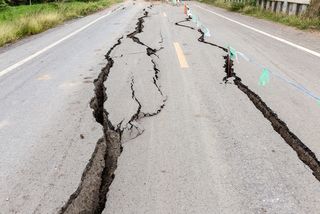
'MyShake' App Turns Your Smartphone into Earthquake Detector

Seismologists and app developers are shaking things up with a new app that transforms smartphones into personal earthquake detectors.
By tapping into a smartphone's accelerometer — the motion-detection instrument — the free Android app, called MyShake, can pick up and interpret nearby quake activity, estimating the earthquake's location and magnitude in real-time, and then relaying the information to a central database for seismologists to analyze.
In time, an established network of users could enable MyShake to be used as an early- warning system, the researchers said. [The 10 Biggest Earthquakes in History]
Crowdsourcing quakes
Seismic networks worldwide detect earthquakes and convey quake data to scientists around the clock, providing a global picture of the tremors that are part of Earth's ongoing dynamic processes. But there are areas where the network is thin, which means researchers are missing pieces in the seismic puzzle. However, "citizen- scientists" with smartphones could fill those gaps, according to Richard Allen, leader of the MyShake project and director of the Berkeley Seismological Laboratory in California.
"As smartphones became more popular and it became easier to write software that would run on smartphones, we realized that we had the potential to use the accelerometer that runs in every smartphone to record earthquakes," Allen told Live Science.
How it works
Sign up for the Live Science daily newsletter now
Get the world’s most fascinating discoveries delivered straight to your inbox.
Accelerometers measure forces related to acceleration: vibration, tilt and movement, and also the static force of gravity's pull. In smartphones, accelerometers detect changes in the device's orientation, allowing the phone to know exactly which end is up and to adjust visual displays to correspond to the direction it's facing.
Fitness apps for smartphones use accelerometers to pinpoint specific changes in motion in order to calculate the number of steps you take, for example. And the MyShake app is designed to recognize when a smartphone's accelerometer picks up the signature shaking of an earthquake, Allen said, which is different from other types of vibrating motion, or "everyday shaking."
In fact, the earthquake-detection engine in MyShake is designed to recognize an earthquake's vibration profile much like a fitness app recognizes steps, according to Allen.
"It's about looking at the amplitude and the frequency content of the earthquake," Allen said, "and it's quite different from the amplitude and frequency content of most everyday shakes. It's very low-frequency energy and the amplitude is not as big as the amplitude for most everyday activities."
In other words, the difference between the highs and lows of the motion generated by an earthquake are smaller than the range you'd find in other types of daily movement, he said.
Quake, rattle and roll
When a smartphone's MyShake app detects an earthquake, it instantly sends an alert to a central processing site. A network detection algorithm is activated by incoming data from multiple phones in the same area, to "declare" an earthquake, identify its location and estimate its magnitude, Allen said.
For now, the app will only collect and transmit data to the central processor. But the end goal, Allen said, is for future versions of the app to send warnings back to individual users.
An iPhone version of the app will also be included in future plans for MyShake, according to Allen.For seismologists, the more data they can gather about earthquakes, the better, Allen said. A bigger data pool means an improved understanding of quake behavior, which could help experts design better early warning systems and safety protocols, things that are especially critical in urban areas prone to frequent quake activity. With 2.6 billion smartphones currently in circulation worldwide and an anticipated 6 billion by 2020, according to an Ericsson Mobility Report released in 2015, a global network of handheld seismic detectors could go a long way toward keeping people safe by improving quake preparation and response.
The findings were published online today (Feb. 12) in the journal Science Advances, and the MyShake app is available for download at myshake.berkeley.edu.
Follow Mindy Weisberger on Twitter and Google+. Follow us @livescience, Facebook & Google+. Original article on Live Science.

Mindy Weisberger is an editor at Scholastic and a former Live Science channel editor and senior writer. She has reported on general science, covering climate change, paleontology, biology, and space. Mindy studied film at Columbia University; prior to Live Science she produced, wrote and directed media for the American Museum of Natural History in New York City. Her videos about dinosaurs, astrophysics, biodiversity and evolution appear in museums and science centers worldwide, earning awards such as the CINE Golden Eagle and the Communicator Award of Excellence. Her writing has also appeared in Scientific American, The Washington Post and How It Works Magazine.
Most Popular

